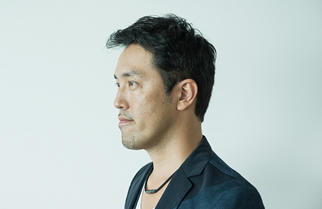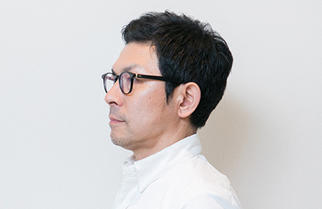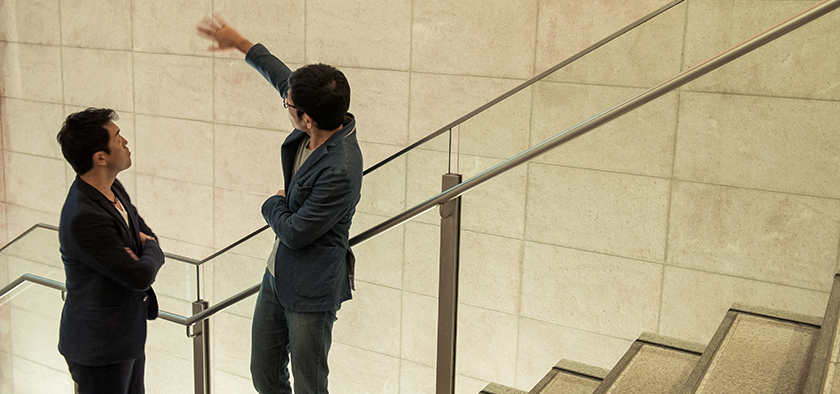
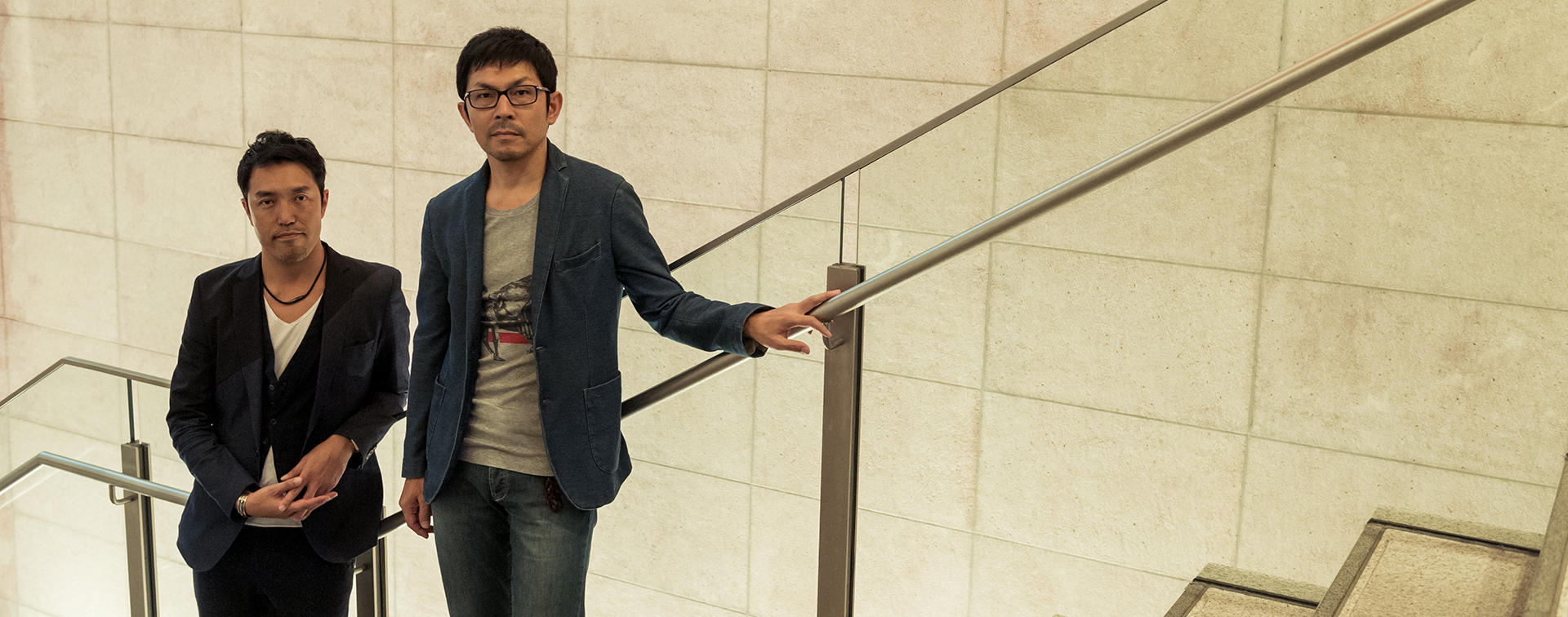
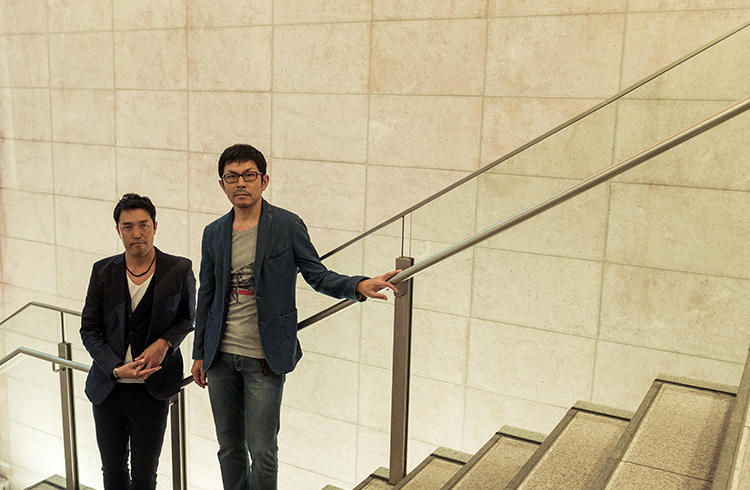
Installtions and people, art and towns
Celebrating media art in Roppongi in February
Visual design studio "WOW" has undertaken many projects including developing application software, designing the background to the credits for the NHK drama television series "Yae no Sakura", and choreographing shows for designer Issey Miyake and the band "World Order". With bases in Tokyo, Sendai and London, WOW is headed by Hiroshi Takahashi (left in photo), executive producer. We interviewed Takahashi and Kosuke Oho (right in photo), WOW's chief creative director. They began by talking about WOW's video installation for the Tokyo Midtown DESIGN TOUCH event to be held in the fall.
Alternately creating things for ourselves and for our clients
Kosuke Oho The installation we've created is based on our design for Epson's "smart canvas" electronic paper watch called "Factory and Fantasy". We will be projecting on a big wall the worldview expressed on this WOW watch.
Hiroshi Takahashi "Factory and Fantasy" actually started out as an installation and was exhibited at the Miyagi Museum of Art in 2007. It was shown in Russian and other countries, and an Epson person who had seen it proposed that we adapt the design for a watch. The drawback to this installation is that it is huge. Its height and width are 40 meters, and we unfortunately had to give up plans to display it in some art museums because it was too big. It's interesting that from this we eventually made a watch - the smallest thing we have ever made.

Factory and Fantasy
WOW's visual installation themed on the boundaries between reality and fantasy. The images were inspired by a dialogue with an expert in cognitive science. At the DESIGN TOUCH event this year, the installation will be set up at Tokyo Midtown B1, with the images projected on the 12-meter wide water-trickling wall (seen in the top main photo).
Oho When we are asked to make something, we usually know the size of the place where the work will be shown, and so we make the work to fit the place. The way we approach a work is determined by the factor of distance - whether it's a small room or a gym-like hall, and whether people are going to look at the work close up or from afar. For the upcoming DESIGN TOUCH event, the installation will be mainly viewed by people walking in the corridor on the first floor and riding the escalators. We plan to make the projection as big as we can so that it can be well seen.
Takahashi "Factory and Fantasy" is a completely original work which we made for ourselves. It was a self-initiated project that happened to lead us to work for a client. The characteristic of WOW is that we alternately make things for ourselves and for our clients.
The appealing untidiness of Roppongi
Oho We've been involved in Roppongi in other ways too. At Roppongi Art Night in 2010, we set up an installation called "ROOFSCPE" at the Canopy Square in Tokyo Midtown. Various images evoking a Roppongi night - such as rows of vending machines and subway neon lights - were projected on a huge cylinder.

ROOFSCAPE
An audio-visual installation set up in Tokyo Midtown's Canopy Square. It incorporates a directivity loudspeaker system which gives off noise. Images are projected on the 7-meter-high cylinder that has a diameter of 2.5 meters. Music to accompany the images begins to play when a person walks near the installation.
Takahashi Also, we had the opportunity to participate in the "KOME - The Art of Rice" exhibition at 21_21 DESIGN SIGHT. I came to Tokyo in 2000, so I don't know much about this area, but Oho told me that when he thought of Roppongi, he would recall the former site of the Defense Agency. Apparently, Roppongi used to be very different.
Oho Tokyo Midtown has been built and the streets have been improved, but about 20 years ago, it wasn't like this at all - the area where the Mercedes Benz shop is now on the Gaien Higashi-dori Street used to be the outskirts. It was a nice, quiet area though. I used to go to the establishments in the backstreets quite often, so I have memories of those times.
Takahashi Good memories?
Oho All kinds of memories. (laughs) It was probably around the time the bubble economy had peaked and was about to end, and there was a very restless feeling in the air. The place was shady, with lots of foreigners. Roppongi was the fun spot for people a little older than us. A person's enthusiasm for Roppongi depends a lot on which generation he belongs to. I guess the same thing can be said for many other towns in Tokyo.
One of the attractive things about Tokyo is that there are many different elements jumbled together, and I think that the contrast of elements is particularly prominent in Roppongi. Shinjuku, for instance, is a place that is not refined, and does not manage to be very chic. But Roppongi has very clean, stylish spaces like Roppongi Hills and Tokyo Midtown, and at the same time, it still has the noisy, restless places in the backstreets.
Takahashi Shabby neon lights and taxis, and glowing traffic pylons at construction work sites.. There are distinctive images that you recall after you've had a drink.
Oho Something I am constantly reminded of when making visual works is that when you control everything from beginning to end, you get a piece of work that lacks appeal. A visual work that is completely controlled is like a brand new condominium. All the rooms are identical and squeaky clean. Things look better when you add a little noise, or an unfathomable bit of space. Roppongi has become tidier, but it hasn't been completely tidied up, and I think that's a very good thing.

Florence, our favorite city
Takahashi In 2007, which was our company's 10th anniversary, we set up our European base in London. We later temporarily moved the base to Florence. The biggest reason for that was the delicious Italian food. Having good food enriches your life, doesn't it? But while the food was good, we found no work in Italy...
Oho We only stayed there for two or three years, but of all the cities in the world, Florence is our favorite city. The whole city is a world heritage site.
Takahashi London has many new buildings and is similar to Tokyo in a way. But in Florence, you can trace its history to the age of the renaissance. In such a classic place we wanted to do take up the challenge of doing new things such as projecting the latest images in an old church.
Oho When you go inside an old building that has been unchanged for several hundred years, you sometimes find that parts of the building have been renovated in a way that expresses ultra-modern sensibilities. The Italians are apparently very fond of that kind of contrast, and we thought it was very attractive too. But works which show the contrast between old and new can only look good in authentic places. In places that are not fully authentic, you don't get stunning results. In Florence though, the charm of such works is enhanced because the whole city is authentic.
Advancing from commercials into other areas
Takahashi In 2007, we published a book to mark WOW's tenth year. We participated in a design event called "TENT LONDON" and sold the book there.
Oho The visual art industry in Japan is very secluded. Most people stay there and don't step out. We were late-comers and we wanted to make visual works that crossed over other industries. Since we happened to have many friends in the fashion and interior design industries, we thought we should do something together. By blending fashion and images, we felt we could create new things and perhaps even invent new ways for using images in live performances. So in the book, we declared that we will actively undertake such projects.
Takahashi We've always sought to expand the realm of our work. We stick to the motto of "those who come are welcome" and try not to refuse offers that come our way.
Oho In Tokyo now, our work consists mainly of setting up large visual installations or creating high-quality visuals for commercials. At the Sendai studio, we have staff headed by a creative director called Kano working mainly in development of application and interface software. Commercial work used to comprise about 60-70 percent of our work, but now comprises 20-30 percent. Our work is currently made up of three pillars - commercials, visual installations, and application software.
Designing a Japanese sword and selling it as an art piece
Takahashi As for the future, we'd like to sell art and put prices on our visual works. I said the same thing in an interview for the AXIS magazine two years ago, but we want to take up the challenge in areas we haven't gone into before. Working from an artist's stance is one of the projects we have in mind.
At the "KOME- The Art of Rice" exhibition, we exhibited a work called "He who does not work, neither shall he eat", and a company owner who saw it said he wanted to buy it. I was intrigued by that, although we ultimately decided not to sell that work.
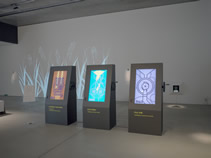
He who does not work, neither shall he eat
An interactive work shown at the 21_21 DESIGN SIGHT's "KOME - The Art of Rice" exhibition. By turning the handles of the installation, visitors can have a simulated experience of the process of harvesting, hulling, milling and polishing rice.
Oho One project that did go through was the creation of the WOW product "aikuchi" which we asked Marc Newson to design.

Aikuchi
A Japanese sword made in the traditional way with an international touch added by product designer Marc Newson. It is the first art piece which WOW has been totally in charge of, from planning to production. 10 sets have been made for buyers worldwide. http://www.w0w.co.jp/aikuchi/
Takahashi It's considerably expensive, with one set costing about the same as a luxury car. The world is wide though. People from Arabia contacted us, and we also got a telephone call from an American Express concierge.
Oho We glimpsed a part of the world we had not known much about. But we were able to reach people other than the usual type of people who view our works, so I guess we aimed right.
Becoming skilled craftsmen to make things that last
Takahashi We made "aikuchi" because my father is a swordsmith. I grew up watching him work and always felt a respect for tradition and culture. I think classical things are essentially the most awesome things. Japanese swords are said to last 1,000 years. There are not many things that last that long. And as a son, I wanted to do something for my father and so I took advantage of my position.
For the last 18 years, we've been making visuals, making works that are fleeting but aiming to make things that would linger in people's minds if only for a short while. And we've now come to do work involving spaces and products, and I had the urge to make something that would last.
Oho Interestingly, swordsmiths are apparently constantly in search of patrons. In the old days, when a feudal lord lost a battle, the swordsmith would find employment with a new feudal lord. I was surprised to hear that swordmiths could transfer like that.
Takahashi The tradition of Japanese swords has been well protected. It's said that after Japan was defeated by America in World War II, General MacArthur immediately came to Japan to buy a sword. Swordsmiths sell their products to all kinds of clients, and the way I work is similar. I feel I need to become a really skilled craftsman.

Holding a Roppongi version of "Ars Electronica"
Oho I wish we could do a media art project in Roppongi. At Roppongi Hills, there is the MEDIA AMBITION TOKYO project led by Jun Tanigawa-san. We took part in that and were able to show our works to people who don't usually appreciate media art.

MEDIA AMBITION TOKYO
An art and technology festival for the latest in art, images, music and performance. The first event was held in February 2013 and drew 14,000 visitors. In 2014, 16 artists including WOW, Rhizomatiks, and Team Lab showed their works for a period of about two months on the 52nd floor of Roppongi Hills and other places.
It would be good if that sort of event could be held in Tokyo Midtown as well. The MEDIA AMBITION TOKYO is held in February which is also the month that the Japan Media Arts Festival is held at the National Art Center, Tokyo. It would be nice if the celebration of media art could draw visitors and enliven the whole area of Roppongi in the way the streets come alive at the Ars Electronica and Milano Salone (Salone Internazionale del Mobile di Milano).
Takahashi It would be good if the event could become like a gateway, introducing visual works and forms of expression that are different from established art, and letting people see that such works can be interesting. I think many of us in the visual works industry hope for that.
Oho Many art projects are already being held in Roppongi, so we hope to contribute by creating new values in visuals.
The unobtrusive, grownup way of using images
Oho Projection mapping has been much talked about in the last few years, but we're not getting excited about it.
Takahashi There's excessiveness in project mapping, don't you think? Since people enjoy it, a part of me tells me to just accept it, but to me, it seems to be a little too much. Nonetheless, it's a welcome trend that people are approving of projection of images on things other than the TV screen. While working with projection mapping and signage lately, I've come to realize that it's very important, although difficult, to not assert too much.
Oho Since we've accumulated experience, I feel that we're getting better at not overdoing it. Projection mapping is still mainly of the assertive, forceful kind, but I think we've had enough of that. We are in favor of using images that are noticeable but not obtrusive, and that are compatible with the environment; we recommend a more grownup way of using images.
Takahashi It's vital that images have a connection to actual things. We made a display installation at SHISEIDO THE GINZA for a beauty essence called "Utlimune". The images projected there have meaning and are linked to the product.
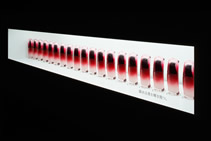
Shiseido's "Ultimune"
WOW designed the installation for the window display at THE GINZA, as well as the 2.5-meter-tall installation set up on the first floor of the store. The large installation featured flowing images expressing the product's concept of "setting free your underlying beauty."
Oho For the display installation, we lined up 20 sophisticated motors and placed the products on top of them. We designed the program so that the products would move and turn one by one. The people at Shiseido said they hadn't done anything like that before and were doubtful at first.
Suggesting ways other than using images
Oho When for example, we are asked to make a window display, we think about what kind of expression is best for the purpose. It's possible to fill the window with lots of images, but that may not necessarily be the best option, and we always keep that in mind. There are times when a client asks us to use images, and we propose doing something else. Nowadays we are increasingly saying, "Maybe you don't need to use images."
Takahashi Those are the times when we step back. (laughs)
Oho There are cases when it's better to use just lighting. Or maybe an effective way would be to simply line up the products, and then perhaps add projection mapping. We've finally come to the stage where we can explore such possibilities. If we had proposed these things 10 years ago, people would not have understood us and things would not have got started. But now, programmers and lighting designers and everyone have accumulated all kinds of experience and we have the skills to make the ideas possible. The foundation has finally been built.
Takahashi Since the foundation has been built, we don't want to erode it. I'm actually quite cautious about exposing ourselves in the media like this. People might think, "Oh they're out there again". And in interviews, when the interviewer is complimentary and says "WOW is great," I want to be modest, so I find it difficult to say, "Yes, it is."
Oho Our work is about making communication through visuals and we think that it might not be good to talk too much. There might be people who have seen our works and will be disillusioned by hearing us talk. We don't want our babble to spoil people's dreams. (laughs)
Editor's thoughts
Takahashi-san said he didn't want to sound boastful. "It's dull listening to other people boast, isn't it?" he said. I was impressed to learn that they are not bent on using images for every work they do, but are open to other ideas and very dedicated to quality. It was clear that Takahashi-san and Oho-san are both very conscientious, with minds of diligent craftsmen. Below is the blog article of the interview. (Japanese version only) (edit_kentaro inoue)
http://6mirai.tokyo-midtown.com/blog/201409/26/1046.php




